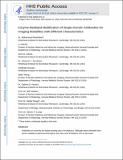Enzyme-Mediated Modification of Single-Domain Antibodies for Imaging Modalities with Different Characteristics
Author(s)
Rashidian, Mohammad; Wang, Lu; Edens, Jerre G.; Jacobsen, Johanne T.; Hossain, Intekhab; Wang, Qifan; Victora, Gabriel D.; Vasdev, Neil; Liang, Steven H.; Ploegh, Hidde; ... Show more Show less
DownloadEnzyme-Mediated Modification.pdf (1.795Mb)
OPEN_ACCESS_POLICY
Open Access Policy
Creative Commons Attribution-Noncommercial-Share Alike
Terms of use
Metadata
Show full item recordAbstract
Antibodies are currently the fastest-growing class of therapeutics. Although naked antibodies have proven valuable as pharmaceutical agents, they have some limitations, such as low tissue penetration and a long circulatory half-life. They have been conjugated to toxic payloads, PEGs, or radioisotopes to increase and optimize their therapeutic efficacy. Although nonspecific conjugation is suitable for most in vitro applications, it has become evident that site specifically modified antibodies may have advantages for in vivo applications. Herein we describe a novel approach in which the antibody fragment is tagged with two handles: one for the introduction of a fluorophore or F isotope, and the second for further modification of the fragment with a PEG moiety or a second antibody fragment to tune its circulatory half-life or its avidity. Such constructs, which recognize Class II MHC products and CD11b, showed high avidity and specificity. They were used to image cancers and could detect small tumors.
Date issued
2016-01Department
Massachusetts Institute of Technology. Department of BiologyJournal
Angewandte Chemie International Edition in English
Publisher
Wiley Blackwell
Citation
Rashidian, Mohammad, Lu Wang, Jerre G. Edens, Johanne T. Jacobsen, Intekhab Hossain, Qifan Wang, Gabriel D. Victora, Neil Vasdev, Hidde Ploegh, and Steven H. Liang. “Enzyme-Mediated Modification of Single-Domain Antibodies for Imaging Modalities with Different Characteristics.” Angewandte Chemie International Edition 55, no. 2 (December 2, 2015): 528–533. © 2016 WILEY-VCH Verlag GmbH & Co. KGaA, Weinheim
Version: Author's final manuscript
ISSN
0570-0833
1521-3773